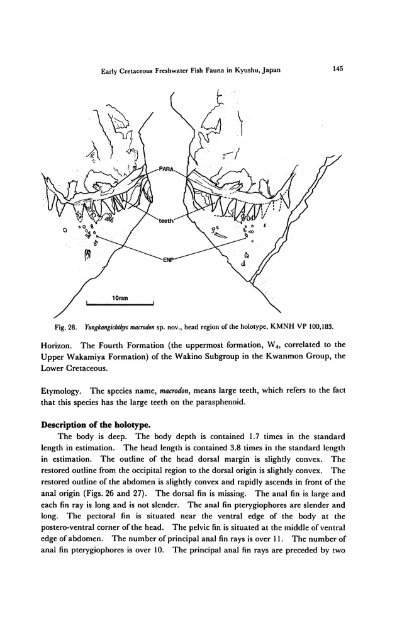Early Cretaceous Freshwater Fish Fauna in Kyushu, Japan
Early Cretaceous Freshwater Fish Fauna in Kyushu, Japan
Early Cretaceous Freshwater Fish Fauna in Kyushu, Japan
Create successful ePaper yourself
Turn your PDF publications into a flip-book with our unique Google optimized e-Paper software.
<strong>Early</strong><strong>Cretaceous</strong> <strong>Freshwater</strong> <strong>Fish</strong> <strong>Fauna</strong> <strong>in</strong> <strong>Kyushu</strong>, <strong>Japan</strong> 145<br />
Fig. 28. Yungkangichthys macrodon sp. nov., head region of the holotype, KMNH VP 100,183.<br />
Horizon. The Fourth Formation (the uppermost formation, W4, correlated to the<br />
Upper Wakamiya Formation) of the Wak<strong>in</strong>o Subgroup <strong>in</strong> the Kwanmon Group, the<br />
Lower <strong>Cretaceous</strong>.<br />
Etymology. The species name, macrodon, means large teeth, which refers to the fact<br />
that this species has the large teeth on the parasphenoid.<br />
Description of the holotype.<br />
The body is deep. The body depth is conta<strong>in</strong>ed 1.7 times <strong>in</strong> the standard<br />
length <strong>in</strong> estimation. The head length is conta<strong>in</strong>ed 3.8 times <strong>in</strong> the standard length<br />
<strong>in</strong> estimation. The outl<strong>in</strong>e of the head dorsal marg<strong>in</strong> is slightly convex. The<br />
restored outl<strong>in</strong>e from the occipital region to the dorsal orig<strong>in</strong> is slightly convex. The<br />
restored outl<strong>in</strong>e of the abdomen is slightly convex and rapidly ascends <strong>in</strong> front of the<br />
anal orig<strong>in</strong> (Figs. 26 and 27). The dorsal f<strong>in</strong> is miss<strong>in</strong>g. The anal f<strong>in</strong> is large and<br />
each f<strong>in</strong> ray is long and is not slender. The anal f<strong>in</strong> pterygiophores are slender and<br />
long. The pectoral f<strong>in</strong> is situated near the ventral edge of the body at the<br />
postero-ventral corner of the head. The pelvic f<strong>in</strong> is situated at the middle ofventral<br />
edge of abdomen. The number of pr<strong>in</strong>cipal anal f<strong>in</strong> rays is over 11. The number of<br />
anal f<strong>in</strong> pterygiophores is over 10. The pr<strong>in</strong>cipal anal f<strong>in</strong> rays are preceded by two

















